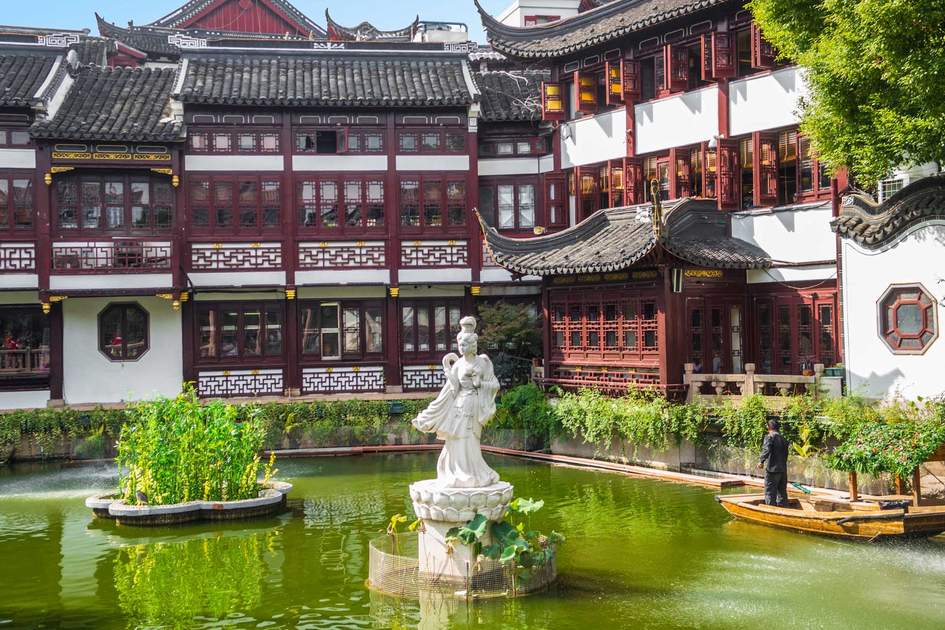Travel back to old Shanghai: Nanshi

During the Concession era, Shanghai's Chinese population was supposed to live in Nanshi, but the stricture quickly broke down. The Chinese soon lived throughout the Concessions – they paid taxes but had no voice in the municipal government – leaving the Old City, with its mysterious maze of lanes, purely Chinese.
Dajing Tower
The only remaining section of the city wall makes an ideal entry point to Nanshi. Dajing Tower is a 1995 recreation of the wall, attached to a refurbished Ming temple which was built in 1553. The ‘Exhibition of the History of Old Shanghai Town’, inside the building, is described entirely in Chinese, but offers an interesting collection of photographs of life in the old days – its festivals, markets and history, along with a miniature model of the Old City’s original layout.
Back lanes
Heading east along nearby Fuyou Road leads you to a couple of the area’s prime attractions for shoppers: the Fuyou Road Merchandise Mart and the Fumin Street Smallware Market. These two warehouse-sized clusters of shops are stocked with what seems like everything under the sun and the vast majority of it is offered at heavily discounted prices.
Chinese markets are not for the faint-hearted. There are live chickens, pigeons and fish, any of which may be killed and cleaned in front of customers in order to guarantee freshness. Further along Fuyou Road, the street narrows to a lane lined with 19th-century buildings housing old apothecaries, pickle stores with gigantic jars, and Shaoxing wine merchants, transporting you into a medieval time warp. Foodies should take a detour onto Sipailou Road, where some of the city’s most delicious street food can be found: from fried noodles, dumplings, kebabs and breads to cotton candy pumped from vintage machines and sugared fruit speared onto sticks. Visit Shanghai's vibrant Old City as part of Insight Guides' Complete China: Beijing, Xi’an and Shanghai trip.
 Detail of the Shanghai's Yuyuan Garden created in the year 1559 by Pan Yunduan. Photo: Shutterstock
Detail of the Shanghai's Yuyuan Garden created in the year 1559 by Pan Yunduan. Photo: Shutterstock
Yu Garden Bazaar
Nearby, the Yu Garden Bazaar is a bold and brash, vehicle-free, reinvented Ming-era Chinese experience centred around speciality shops and delicious local snacks. Follow the signs to Nanxiang Mantou Dian, which is encircled by the most popular food stalls in the bazaar. Here you can find Shanghai’s famous delicacies: the bite-sized, translucent xiao long bao (pork dumplings) and anchun jiaozi (sweet rice pigeon egg dumplings). The queues for street food are sometimes lengthy meaning you might want to consider dining at one of the Old City’s famous restaurants. Places such as Shanghai Classic Restaurant, which has been in business since 1875, and Green Wave Pavilion Restaurant serve the famous snacks alongside menus of speciality Shanghainese dishes.
Yuyuan garden
At the centre of the bazaar is one of the most visited spots within the Old town, the Yuyuan garden. Also referred to as the Yu garden, it was created in 1577 by Ming dynasty official Pan Yunduan to please his elderly father by creating a calm place for him to relax in. The garden gets its name from the Chinese word for peace and comfort, yu. Its walls encircled by an undulating dragon, Yu Garden is a petite classical Suzhou-style garden that has all the ingredients required to create a microcosm of the universe – the defining hallmark of the classical Chinese garden. It features 30 pavilions connected by bridges and walkways, interspersed with fishponds, rockeries and ingenious views. Visit the ground in early spring to see the garden in full bloom. Unfortunately, Yu Garden is often invaded by large tourist groups with loudspeaker-blasting guides, crowding what is meant to be a space for quiet contemplation. To avoid these groups, visit as early as possible, ideally at 8.30am when the gardens open.
 The Huxinting Teahouse. Photo: Shutterstock
The Huxinting Teahouse. Photo: Shutterstock
The Huxinting Teahouse
The Huxinting Teahouse is set in the centre of a man-made lake. Perhaps because the five-sided teahouse, with its classical pointed roof, has hosted the likes of Queen Elizabeth and Bill Clinton, a cup of tea here costs Rmb50, more than US$7. Still, sipping delicate Chinese tea from a Yixing teacup on the second floor, as you take in views of willows and treetops in Yu Garden, is an experience to savour. If you prefer a caffeine-free drink, choose for one of the flower teas, Jasmine is a favourite amongst locals.
At the teahouse, waitresses pour tea from the tiny maroon-brown spout of a Yixing teapot, the vessel that tea connoisseurs say brews the finest tea. Made from the purple clay found only in Jiangsu province’s Yixing county, the teapots are unglazed inside and out, and this porous quality allows it to become seasoned over time from both the colour and flavour of the tea. Usually, only one type of tea is used in a pot to maintain its purity. Tea experts say that a quality teapot should make a clear sound when struck, and the tea should pour out from the spout in a smooth arc.
Ready to explore Shanghai?
Our local experts can plan fascinating trips to Shanghai for you. Simply get in touch, telling us when you'd like to travel, and your ideas for the trip. We will then create an itinerary for you, which you can amend until you're totally happy with every detail before booking. Our existing itineraries can offer inspiration, and remember that all of our planned itineraries can be tailored to suit your needs.





